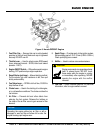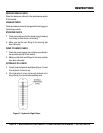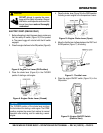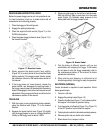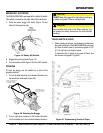
Before the power buggy can be put into operational use,
it is best to perform a test run to make certain that all
components are functioning properly.
1. Place the buggy on flat solid ground.
2. Engage the parking brake lever.
3. Place the engine's throttle control (Figure 11) in the
SLOW (idle) position.
4. Place the power buggy's direction lever (Figure 17) in
the forward direction.
Figure 17. Direction Lever
5. Slowly squeeze the speed control lever slightly
(Figure 16), for a short period of time to test the brake
holding capacity. If the buggy moves forward, adjust
the brakes as outlined in the maintenance section of
this manual.
6. If the buggy does not move forward, release the
speed control, and disengage the parking brake. If
the buggy creeps forward or reverse while the parking
brake is disengaged, the machine will require service
adjustment of the pump control lever as outlined in the
maintenance section of this manual.
1. With the engine running and parking brake released,
place the direction lever (Figure 17) in the forward
direction.
2. Squeeze the speed control lever (Figure 16) slightly
until the buggy begins to move in a forward direction.
Initially, let the buggy travel at about 3 MPH.
OPERATION
3. When using the buggy for the first time, test the brake.
With the right foot, step up and place it on the brake
pedal (Figure 18). Gradually apply pressure to the
brake pedal until the buggy comes to rest.
Figure 18. Brake Pedal
4. Test the brake at different speeds until you are
comfortable with stopping the buggy. If the brakes
do not seem to stop the buggy adequately, refer to
the maintenance section of this manual for brake
adjustment instructions.
5. When starting and stopping is confirmed to be
functioning properly, the buggy is ready for operation.
Correct shutdown is important to safe operation. Follow
these general steps:
1. Come to a full stop.
2. Engage the parking brake (Figure 15).
3. Place the throttle lever (Figure 11) in the slow position.
Idle engine 3-5 minutes for gradual cooling.
4. Turn the engine on/off switch (Figure 12 or Figure 13)
to the OFF position to shut down the engine.
5. Cycle hydraulic controls to eliminate residual pressure.
6. Remove ignition key on electric start models.
7. Block wheels if on a slope or incline.






